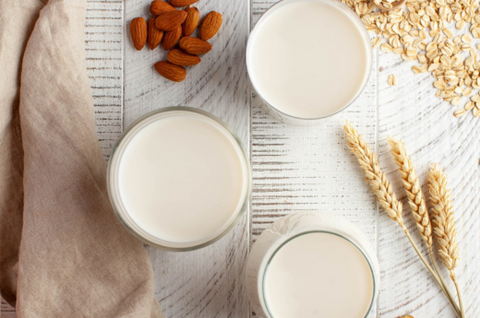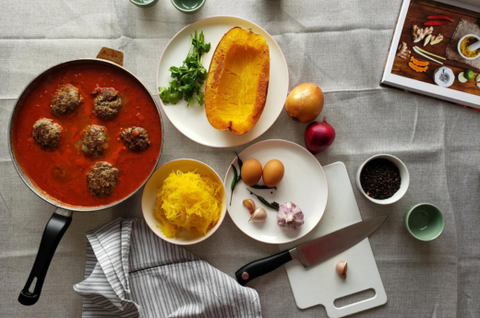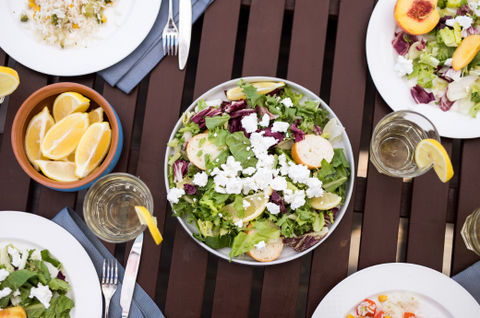Are you looking for an easy way to ditch dairy? Making the switch from a diet that includes dairy products to one that does not can be difficult and overwhelming. But, with the right guidance and preparation, it doesn't have to be! In this blog post, we’re going to provide you with the top 10 tips for making the transition away from dairy as painless and successful as possible.
Read on for key information about what foods are ok when maintaining a dairy-free lifestyle, how to read nutrition labels so you know exactly what ingredients are in each product, plus other tricks of the trade – all designed to make your journey towards being dairy-free both informative and enjoyable!

Understand the Benefits of Going Dairy-Free - discuss why going dairy-free may be beneficial for your health and wellbeing
Switching to a dairy-free diet can have numerous benefits for your health and overall well-being. One of the most popular reasons for going dairy-free is to reduce symptoms of lactose intolerance or dairy allergies. By eliminating dairy products from your diet, you can alleviate bloating, gas, and other digestive discomforts that commonly result from dairy consumption.
Going dairy-free helps reduce inflammation in the body. Dairy is a common source of inflammatory proteins, which have been linked to numerous chronic health conditions such as asthma, rheumatoid arthritis, and type 2 diabetes.
Going dairy-free can also help with weight management, as dairy products often contain high amounts of calories and fat. Additionally, dairy-free alternatives such as soy, almond, and coconut milk, are packed with essential nutrients and vitamins such as calcium and vitamin D. A dairy-free diet can have positive effects on your health, leaving you feeling energized and refreshed.
Finally, going dairy-free may also support weight loss goals. Dairy often contains high amounts of added sugars and fats, which are associated with weight gain when consumed in excess. Cutting out these foods can make it easier to maintain a healthy calorie balance for effective weight management.

Make a Meal Plan - outline how to plan meals ahead of time to ensure you don't miss out on essential nutrients
Planning meals ahead of time is an essential part of maintaining a healthy lifestyle. Skipping meals or relying on fast food can result in missing out on crucial nutrients that your body needs to function properly.
To make a meal plan, start by creating a grocery list of healthy and nutritious foods. Consider incorporating a variety of fruits, vegetables, whole grains, lean proteins, and healthy fats into your plan. Plan your meals for the week ahead, taking into account your schedule and any events that may impact your eating habits. Meal planning not only ensures that you receive the necessary nutrients, but it also saves time, reduces stress, and encourages healthier habits overall. By making a meal plan, you'll be on your way to a healthier and more balanced lifestyle.

Find Dairy Alternatives - provide options for finding non-dairy alternatives for foods such as milk and cheese
As more and more people turn to a vegan or lactose-free lifestyle, finding dairy alternatives is becoming increasingly important. Fortunately, with the rise of this lifestyle choice, there are a plethora of options available now. Some popular non-dairy milk options include almond, soy, coconut, and oat milk. For cheese alternatives, plant-based options like Violife and Daiya offer delicious options for everything from shredded cheese to cream cheese.
For those looking for a plant-based alternative to yogurt, coconut yogurt is an excellent choice. For more of a savory treat, vegan cheese slices like Follow Your Heart's American Style Slices can provide the same flavor as their dairy counterparts. If you're feeling adventurous and want something similar to sour cream or mayonnaise, try using blended cashews instead! With so many tasty options out there, finding dairy alternatives doesn't have to be difficult. Whether you're lactose intolerant or trying to transition to a vegan lifestyle, there are plenty of flavorful solutions for all your eating needs.
In addition, many grocery stores now have dedicated dairy-free sections as well as vegan-friendly options throughout the store. Finding dairy alternatives has never been easier, and the benefits to our health and the environment make it well worth the switch.

Don't Skip Essential Nutrients - list important nutrients that are commonly found in dairy products, such as calcium and vitamin D, and explore ways to get them from other sources
Ensuring that you get all the essential nutrients your body requires is crucial to maintaining good health - yet many people overlook those that are crucially found in dairy products. Calcium and vitamin D are two of the most important, both for building strong bones and supporting the immune system.
However, there are a number of alternative sources that can be incorporated into your diet - leafy green vegetables, nuts, and certain types of fish all provide high levels of these key nutrients. So even if you're lactose intolerant or simply want to mix things up a bit, there are still plenty of options available to help you maintain a well-rounded, healthy diet.

Educate Yourself on Labels - explain how to read food labels so you can spot hidden sources of dairy
As a consumer, it's important to educate yourself on how to read food labels properly. In doing so, you can spot hidden sources of dairy that may not be immediately obvious. Always start by checking the ingredients list, as milk or any of its derivatives are required to be listed. However, it's not always just about the obvious ingredients. Be on the lookout for other hidden sources, like casein or whey protein.
Also, take note of any allergen warnings, such as "may contain milk". It's crucial to be diligent when reading food labels, especially if you have a dairy allergy or intolerance. Always check the allergen information section which will help you identify whether the product contains milk proteins or other forms of dairy. Doing so ensures that you can enjoy food that meets your dietary needs with confidence. With a little bit of knowledge about how to read food labels properly, you can easily spot hidden sources of dairy and make informed decisions when shopping for groceries. By understanding how to read labels, you'll be making informed choices about the foods you consume, leading to a healthier and happier you.

Find Creative Recipes - include some creative recipes that are dairy-free but still delicious and satisfying
In the world of diets and food restrictions, finding tasty and creative recipes that are also dairy-free can often be challenging. But don't worry, there are plenty of flavorful options that don't require any dairy products. If you're in need of inspiration, consider whipping up some roasted vegetables with garlic and herbs, savory and spicy lentil soup, or a hearty quinoa salad with plenty of fresh herbs and veggies.
If you're looking to switch up your dinner routine and incorporate some dairy-free recipes into the mix, consider trying these delicious options. Roasted vegetables are an easy and flavorful side dish that can be enjoyed with any meal. Simply toss the vegetables of your choice in olive oil, minced garlic, chopped fresh herbs, and salt and pepper before baking at 400°F until they’re tender. Another great option is a savory lentil soup featuring plenty of aromatics such as onion and garlic, plus your favorite spices—paprika or cumin would be nice additions. Finally, quinoa salads make for a filling entrée that’s both healthy and satisfying. Try combining cooked quinoa with whatever seasonal veggies you have on hand, some nuts and seeds of your choice, and a flavorful vinaigrette. With these dairy-free recipes, you can enjoy delicious meals without sacrificing flavor or satisfaction.
These recipes are just a few examples of the countless possibilities available to those who are looking to eat a more plant-based, dairy-free diet. So whether you're lactose-intolerant or simply looking for some tasty new recipe ideas, try incorporating some of these scrumptious dishes into your meal plan today.
Going dairy-free can seem like a daunting task, but it doesn't have to be. With careful meal planning and an exploration of some delicious and creative recipes, you'll soon be able to enjoy a nutritious diet without feeling deprived.
Additionally, taking the time to educate yourself on food labels and familiarize yourself with the various sources of essential nutrients is key to creating a balanced diet. Ultimately, while going dairy-free isn't for everyone, it can provide many health benefits and make eating healthy easier than ever before.
No matter what your dietary preferences are, you don't have to miss out on the flavor of traditional dairy products. With just a bit of research and experimentation, you can find plenty of delicious non-dairy options that will please even the most discerning palate. Plus, many vegan options are lower in calories and fat than their dairy counterparts so you can still enjoy all your favorites without feeling guilty about it! So go ahead and explore all the delicious possibilities offered by dairy alternatives – your taste buds won’t be disappointed.
Happy eating!
Frequently Asked Questions
Does chocolate have dairy?
Chocolate may contain dairy, depending on the type and brand of chocolate. Milk chocolate, for example, contains milk powder or milk solids as it’s one of the main ingredients. This is what gives milk chocolate its smooth and creamy texture.
Semi-sweet chocolate or dark chocolate, on the other hand, typically does not have milk as an ingredient, but it's always important to check the label carefully as some manufacturers may use milk as an additive.
Is chocolate lactose free?
Some types of chocolate are lactose-free, while others may contain lactose depending on the specific ingredients used. Dark chocolate, for example, generally does not contain lactose as it is often made using only cocoa solids, cocoa butter, and sugar. However, it's always important to check the ingredient list on the label, as some manufacturers may add small amounts of milk or milk derivatives to dark chocolate.
Milk chocolate, on the other hand, typically contains lactose as it contains milk powder or milk solids as one of its main ingredients. If you are lactose-intolerant, you can look for dairy-free chocolate that is specifically labeled as lactose-free or vegan.
What does non dairy mean?
Non-dairy means that a food product does not contain any animal milk or milk-based products such as butter, cream, cheese, or yogurt. This is important for people who are lactose intolerant or allergic to milk proteins, or those following a vegan or plant-based diet.
How to make dairy free chocolate cake?
Here is a recipe for a dairy-free chocolate cake:
Ingredients:
- 1 1/2 cups all-purpose flour
- 1 cup granulated sugar
- 1/2 cup cocoa powder
- 1 tsp baking soda
- 1/2 tsp salt
- 1/3 cup vegetable oil
- 1 tbsp white vinegar
- 1 tsp vanilla extract
- 1 cup water
Instructions:
-
Preheat the oven to 350°F (180°C) and grease an 8-inch cake pan with cooking spray or dairy-free butter.
-
In a large mixing bowl, whisk together the flour, sugar, cocoa powder, baking soda, and salt.
-
In a separate mixing bowl, mix together the vegetable oil, vinegar, vanilla extract, and water.
-
Add the wet ingredients to the dry ingredients and stir until smooth, being careful not to overmix.
-
Pour the batter into the greased cake pan and bake for 30-35 minutes, or until a toothpick inserted into the center of the cake comes out clean.
-
Remove the cake from the oven and allow it to cool in the pan for 10 minutes.
-
Carefully transfer the cake onto a wire rack and continue to cool completely.
-
Dust with powdered sugar or make a dairy-free frosting to add to the cake.
Optional: To make a chocolate frosting, you can mix powdered sugar, cocoa powder, vanilla extract, and coconut milk until you get your desired consistency.
Enjoy your delicious dairy-free chocolate cake!





Comments (0)
There are no comments for this article. Be the first one to leave a message!